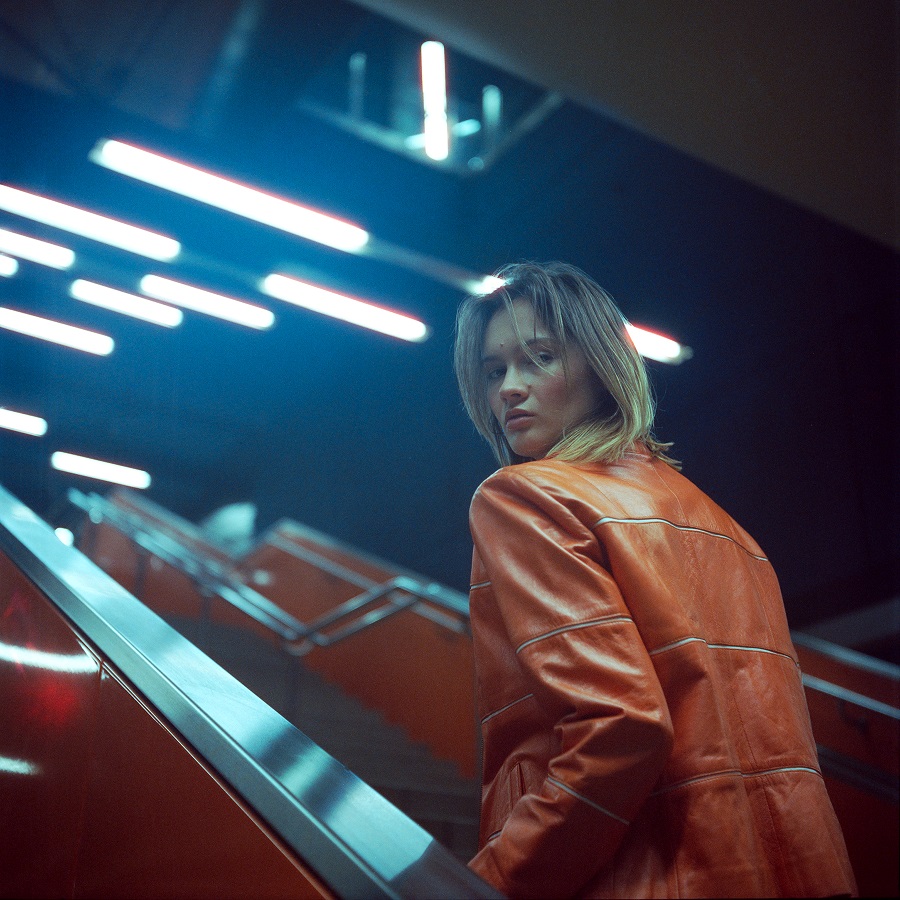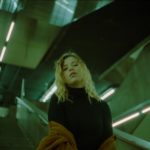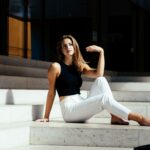How film changed my perspective as a portrait photographer

Updated 2024
I know I only wrote about analog photography, but I didn’t yet talk about its importance for me as a portrait photographer. The reason for this is that I was simply a bit cautious about shooting portraits on film because… it’s simply much more difficult, here is why:
- You only have 36 shots per film (with medium format even only 10-16)
- It is not possible to see if an image actually worked until the film is developed
- Continuous shooting to prevent, for example, the blink of an eye or something similar is not possible
- It can take weeks until the film is finished and developed
- If you scan or even develop yourself, each film requires a lot of work
- If you don’t scan yourself, you have little influence on the editing/white balance of the images
- You have to think about what the pictures should look like in advance and the time of the day you’ll be taking images, because a film and its optics remain in the camera until it is finished shooting
To list just a few of the “disadvantages” of analogue craftsmanship in portrait photography. Disadvantages in quotes because in my opinion it’s more of a blessing in disguise. Paradoxically, it seems to me that restrictions challenge and encourage our creativity more than limitless freedom does.
This is especially true if, like me, you work as a portrait photographer and have already developed a routine with your digital equipment that is difficult to break out of.

Fewer pictures is more, even as a portrait photographer
Of course, the limitation of 36 images per film seems a bit tight and uncomfortable at first. A limitation that I didn’t know about as a portrait photographer with digital cameras and that’s why I took pretty pictures without thinking too much about it.
Of course, I still do this to some extent during commissioned shoots so that I can offer my customers as wide a selection as possible and not all the images turn out to be perfect, but it is always safer. With analog, however, I think five times whether a situation is worth a photo or not.
Since I started taking analogue photographs, I’ve taken a lot fewer images. I stand in front of compositions, look at the light, the elements in the foreground and background, take a look through the viewfinder and… then leave it alone because it’s not worth a photo for me (it also costs at least 50 cents or a euro per image). When I finish a film, I can still remember most of the pictures I took and know exactly what fascinated me about the image.
Deeper connection to each individual image
Having this connection with every picture, instead of just randomly shooting a few hundred files onto a storage medium, becomes much, much more personal when you work as a portrait photographer and have a person in front of the camera. But are the 36 pictures enough?

Short answer: yes, since every exposure is thought through, significantly fewer are needed anyway. Actually, I rarely finish exposing a film during one shoot, most of the time like 24 pictures are more than enough. By the way, digitally for me it is quite the opposite, I usually end up with a few hundred images at the end, of which over half are sorted out.
During my first paid portrait shoot on film, I was acutally struggling to get the whole role of film finished, it took us almost five hours.
And I can do almost anything with the digital pictures lookwise, but with film, thats a completely different story.
The look is choosen before you even take the photo
when you get started on your film journey it might not cross your mind at first, but it plays a crucial role (pun intended) which film you bring with you for a portrait shoot. There are high contrast, flat, black and white, color shifted films and all of them are for different times of day.
In practice, this means that you can rarely shoot with the same film throughout a whole day, because a film used in daylight will have troubles working at dusk and, conversely, a film designed for night and tungsten light will produce poor results in daylight.
And that completely turns the work process on its head compared to digital. While as a portrait photographer with a digital camera I can shoot in a completely relaxed manner and can take all the freedom I need in post-processing afterwards: But when taking film photos, I have to think beforehand about how the light will be like, what color look I want or how much grain and contrast I want to introduce into my images.
That is of course limiting. For example, I had a film for very bright daylight in my camera for almost a whole month and I just couldn’t finish it because I didnt had the time to go out in the blazing midday sun or the days were simply too cloudy. For a portrait shoot, this means that the choice of film must be carefully planned in advance. Of course, this doesn’t make the process any easier compared to digital photography, but it makes it significantly more interesting, exciting and… nerdier.

There’s also a bit of charm buried here, because trying out different films, underexposing and overexposing or experiment with double exposures is not only fun and satisfies your native hunting and gathering instinct (I now have at least nine films hoarded in my fridge), but is also incredibly creative.
In the spring, for example, I had to finish shooting a daylight film at dusk during a portrait shoot so that I could switch to a brighter film. The result were really interesting portraits with underexposed film that immediately blew me away: a really nice accident.
Like I mentioned before, I do remember most of the shots I took before I get them back from developement and when I finally get them, it’s time to review what worked and what could have been done better.
You look at your work more often, more thoroughly and more thoughtfully
In addition to the more exciting colors and retro look, 35 mm negatives have one thing in particular and that is significantly less detail than their electronic successors. This means that when you switch to film you lose the luxury of being able to crop the images afterwards.
That’s exactly why, when you finally have them in your hand, you look at individual shots much longer and more critically – think about which elements you shouldn’t have included in the picture or why a composition didn’t work.
In my work as a digital portrait photographer, I have gotten into the habit of taking a lot of pictures of a scene and moving around to get different perspectives and details. I rarely or never really thought about why I do it this way or which image sections I might leave out of the next shoot because I don’t like them. I didn’t have to either. After all, an image can be cropped in post-production without much loss of quality and there is plenty of storage space on the card.

Analogue portrait photography creates a more intensive learning effect. I’ve been slowly and painfully discovering my bad digital habits one roll of film at a time for over the years. Because in analogue photography it hurts if you have to cut away a third of the image or if you messed up a exposure.
More than just overly complicated digital photography
An image with incorrect focus, on a 120 film with 12 exposures is something you’ll remember and be bitter about for a long time. Cutting out a third of the image because the composition wasn’t right hurts a lot. A portrait with the beautiful colors of the evening sun on a Porta 400, which unfortunately has lost a lot of details due to underexposure, burns itself into my craft as a portrait photographer because it is really annoying to have messed it up:
While, it also motivates me to further sharpen my skills. Looking at you Pentax 6×7 and all the hardships I had getting to know you.
When shooting digitally, it’s easy to fall into the same routines, the same pins/inspirations that you know will work. Analogue film photography is more than just more difficult digital portraiture. It is a rethinking/method to question the habitual patterns of one’s own photography and to further develop the craft.
That being said, should every photographer now start taking analogue photographs? Please don’t.
Shooting film alone doesn’t make anyone a better photographer
On the one hand, “Please don’t” because analogue cameras are becoming more and more expensive and are no longer produced, leave them for me. Furthermore, I don’t believe that the recipe of “shooting analogue portraits makes you a better portrait photographer” always works. In my opinion, the topic is relevant for available light or street photographers, but not so much for colleagues who work in the studio or events, like sport or weddings.

Likewise, a lot depends on the person behind the lens. I know photographers who love to shoot wildly, who would never pass on the wide editing options of a digital negative and whose hearts soar when they can buy the latest autofocus and the largest megapixel sensors.
For such photographers, an analog camera is probably pure torture and frustration because the images are not guaranteed to work and waiting for development doesn’t fit with the mentality at all. But the worst thing would be photographers for whom the cameras and lenses represent status symbols (greetings to the Urban-Ninjas and the Leica selfie crew):
No new analogue cameras are being manufactured anymore and it would be a great shame if these charming, mechanical devices were used as decorative objects for Ikea wall shelves or end up as mere props for models. Although, Leica just reintroduced their M6, but more on that in this blog article.
You have to be able to enjoy analog photography
When a portrait shoot becomes more of a series of repetitive steps than a challenge. Or when taking photos in your free time becomes less and less fun because you feel like you’ve already seen everything on social media or captured something similar. Or simply when you want to get closer to the roots of the medium.
Then you should buy an analog camera, then you can only win with this type of photography as long as you have the patience to rediscover something you have already learned. Read about my first contact with film photography here and believe me, it was a rough start for sure, but worth it.
I think a deep enthusiasm and fascination with the medium of photography and curiosity for the old school is also a great advantage if you want to do analog portraits. And especially when you feel like using really nice cameras that look stylish and sound great.
With that in mind, here is a link to my offer as a portrait photographer coach, also in analogue photography. Shameless self advertisment, I know.





